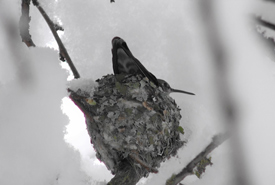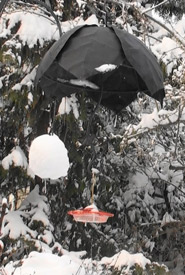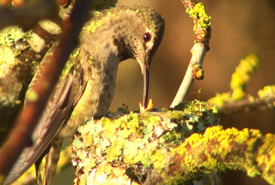The hummingbird's igloo

Sweetiebird, an Anna's hummingbird, in her igloo. (Photo by Eric Pittman)
I always thought of hummingbirds as warm-weather birds. So I was surprised to see an Anna's hummingbird building a nest in early February. I was even more surprised because it was its sixth nest in a year, built in our yard.
I live in Victoria, British Columbia, which has the most temperate climate in Canada. Because snow is a rare occurrence, Anna's hummingbirds stay all year and don't migrate. Our backyard resident, known affectionately as Sweetiebird, claimed our yard for herself and had four successful nests the preceding summer in our fruit trees. I eagerly filmed each clutch as they grew from tiny eggs to little flying pollinators.

A hanging metal umbrella was used to shield the feeder from the snow. (Photo by Eric Pittman)
Sweetiebird started building her fifth nest in our yard on Christmas day, but due to heavy rainfall couldn't complete construction and the nest fell apart. Given the bird’s prolific nature, I wasn’t too surprised when she started building another nest in the plum tree in early February. Soon, Sweetiebird was incubating and things were looking good.
But then an arctic blast hit our area. It began to snow and temperatures plunged to minus 20. The feeders froze solid in hours. Since Sweetiebird had already laid her eggs, she was committed to staying on the nest. Snow blanketed everything overnight and I was worried for the hummingbird. At first light, I wiped the snow off the feeders but saw that Sweetiebird and the nest were completely covered.
I wondered what I could possibly do to help.

Sweetiebird feeds her chicks after the weather warms up. (Photo by Eric Pittman)
I expected the worst, but then I heard Sweetiebird chirp and saw her dart out of the tree! Somehow, the bird had cleared away enough snow to get free. As I crept carefully under the branches, I saw that the snow was so fluffy it had created little pockets, making a tiny igloo. Sweetiebird's constant movement beneath the snow had helped carve out a little snow shelter for herself that was accessible from below so she could come and go as she pleased.
Thankful that Sweetiebird had survived the night, I kept the feeders warm by keeping a few inside to swap with the cold feeders outside. After about five days, the arctic blast passed and we were back to our usual temperate climate.
The hummingbird’s resilience surprised me and showed me just how tenacious these little birds can be.
If you have a resident hummingbird in your backyard, here are three tips to help keep nests thriving:
- Raise the sugar to water ratio in the feeders to 1 cup of sugar to 3 cups of water. In the summer, it's normally 1 cup of sugar to 4 cups of water. The extra sugar gives them just a bit more energy.
- Have more than one feeder and keep one inside your house to swap with the outside one if it starts to freeze or gets too cold. Hummingbirds don't feed at night, so you can take the feeder in after dark, but be sure to put it out again at first light — the birds will need it.
- Place an umbrella-shaped covering over the feeder to reduce the amount of snow that settles on it. Hummingbirds can't feed unless they can see where the feeder hole is, so you have to keep it visible.
Want to watch Sweetiebird in action? Click the video below:


